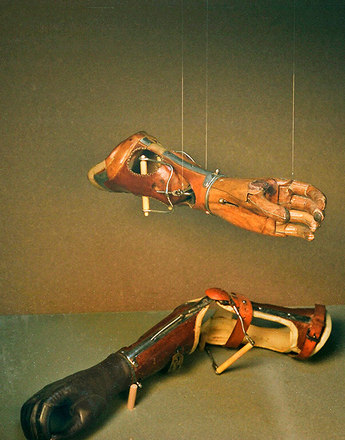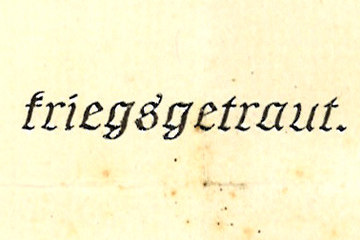During the First World War there was a significant increase in venereal diseases. Before the war, 5.6 per cent of Austro-Hungarian soldiers suffered from a venereal disease. By 1915 the level had risen to 12.2 per cent.
At the barracks in Innsbruck/Hall the number of soldiers infected with gonorrhoea and syphilis increased markedly during the war. In 1909, only 34 soldiers had gonorrhoea and 24 syphilis. By 1915 the corresponding figures were 1,691 and 1,007. In the first three years of the war 1,275,000 soldiers in the Austro-Hungarian army contracted a venereal disease. Most were infected not at the front but behind the lines or during the long marches to the front.
Among the measures taken in the Austro-Hungarian empire to combat venereal diseases was the ban on infected soldiers being treated by civilian doctors. This was designed to monitor and curb the spread of venereal diseases within the army. Although it was obligatory for such cases to be reported, the treating physicians were not always conscientious in this regard. The compulsory measures often made those concerned reluctant to disclose their infection and have it treated. After July 1916 the military authorities demanded a detailed list of infected soldiers and a record of their treatment.
As a further measure, there were regular inspections of the troops, known familiarly as “dick parades”. The army doctor examined the genitals of every soldier in the entire unit for signs of a venereal disease. Applications for leave by soldiers suffering from a venereal disease were also refused so as to prevent the spread behind the lines.
Some medical experts doubted the effectiveness of the compulsory military measures.
A letter by the Association of Doctors of German Tyrol in October 1915 stated:
“All experts today are agreed that strict police measures do not prevent the spread of venereal diseases but rather encourage it and that the only way of preventing them is to make it as easy as possible for patients to obtain medical treatment until the condition is cured. The application of coercion to combat venereal diseases has always resulted in these diseases […] being concealed even more than would have been the case. If doctors are forced to report such diseases, […] the sufferers will no longer go to the doctor at all, thereby delaying their recovery and endangering other people through the possibility of contagion."
Translation: Nick Somers
Biwald, Brigitte: Von Helden und Krüppeln. Das österreichisch-ungarische Militärsanitätswesen im Ersten Weltkrieg. Teil 2, Wien 2002
Dietrich, Elisabeth: Der andere Tod. Seuchen, Volkskrankheiten und Gesundheitswesen im Ersten Weltkrieg, in: Eisterer, Klaus/Steininger, Rolf (Hrsg.): Tirol und der Erste Weltkrieg, Innsbruck 2011, 255-275
Rhoades, Michelle K.: Renegotiating French Masculinity. Medicine and Venereal Disease during the Great War, in: French Historical Studies (2006), 29/2, 293-327
Sauerteig, Lutz: Militär, Medizin und Moral: Sexualität im Ersten Weltkrieg, in: Eckart, Wolfgang U./Gradmann, Christoph (Hrsg.): Die Medizin und der Erste Weltkrieg, 2. Auflage, Herbolzheim 2003, 197-226
Überegger, Oswald: Krieg als sexuelle Zäsur? Sexualmoral und Geschlechterstereotypen im kriegsgesellschaftlichen Diskurs über die Geschlechtskrankheiten. Kulturgeschichtliche Annäherungen, in: Kuprian, Hermann J. W./Überegger, Oswald (Hrsg.): Der Erste Weltkrieg im Alpenraum. Erfahrung, Deutung, Erinnerung. La Grande Guerra nell’arco alpino. Esperienze e memoria, Innsbruck 2006, 351-366
Wingfield, Nancy M.: The Enemy Within. Regulating Prostitution and Controlling Venereal Disease in Cisleithanian Austria during the Great War, in: Central European History (2013), 46/3, 568-598
Quotes:
“All experts today ...": Verein der Ärzte Deutschtirols an Statthalterei Innsbruck, 22.10.1915, quoted from: Überegger, Oswald: Krieg als sexuelle Zäsur? Sexualmoral und Geschlechterstereotypen im kriegsgesellschaftlichen Diskurs über die Geschlechtskrankheiten. Kulturgeschichtliche Annäherungen, in: Kuprian, Hermann J. W./Überegger, Oswald (Hrsg.): Der Erste Weltkrieg im Alpenraum. Erfahrung, Deutung, Erinnerung. La Grande Guerra nell’arco alpino. Esperienze e memoria, Innsbruck 2006, 356 (Translation)
-
Chapters
- Separation of husbands and wives and sexual mobility in the First World War
- Dwindling birth rates during the First World War
- "Mobilisation of the cradle"
- State control and social stigma
- Abstinence and satisfaction of needs
- Combatting venereal diseases in the Austro-Hungarian army
- “Resist from the outset”
- Sexual relief for soldiers
- Prevention or punishment
- Sexual assault in the First World War
- Sexual violence in Allied war propaganda





